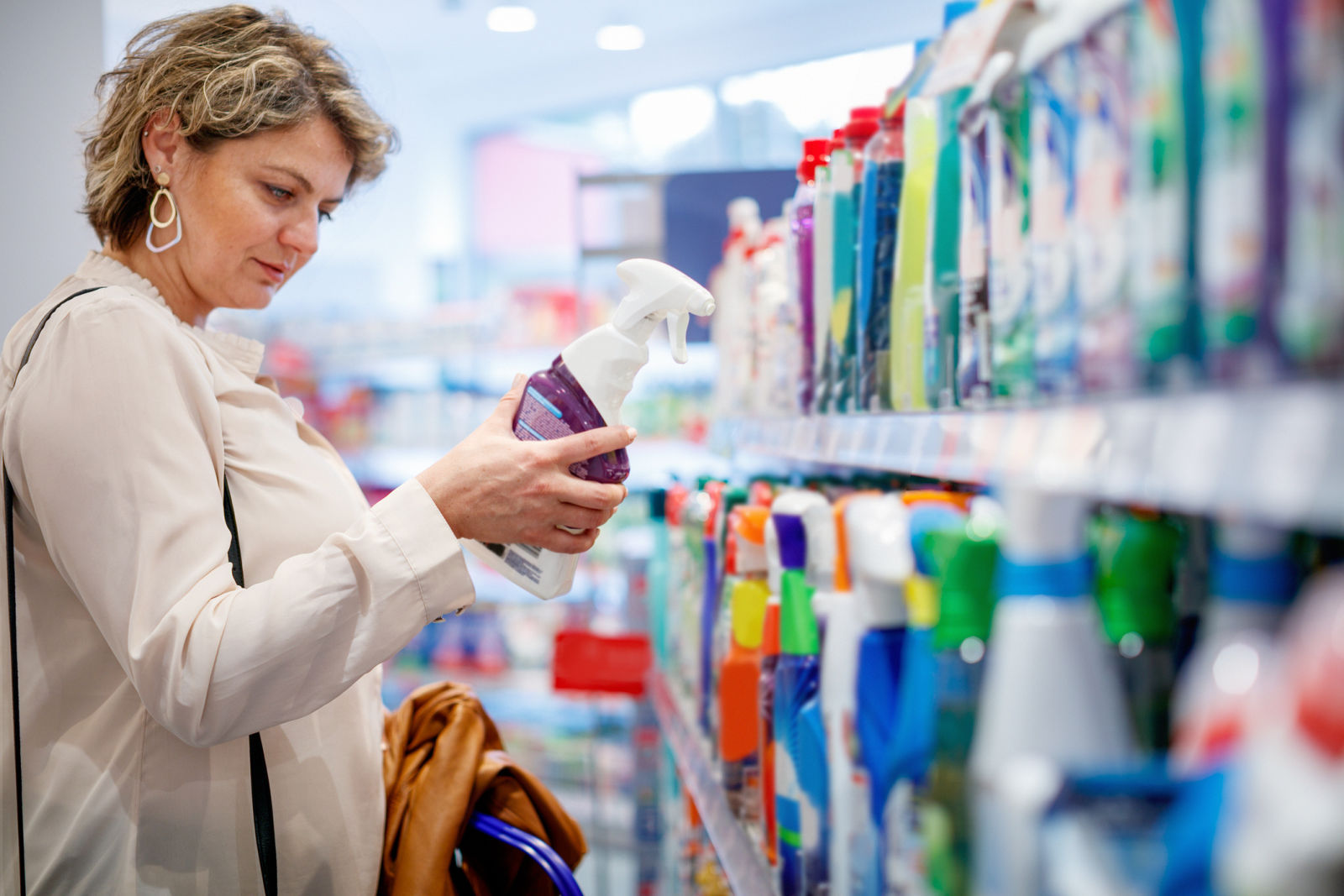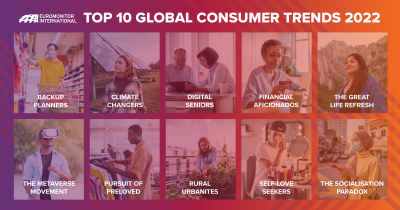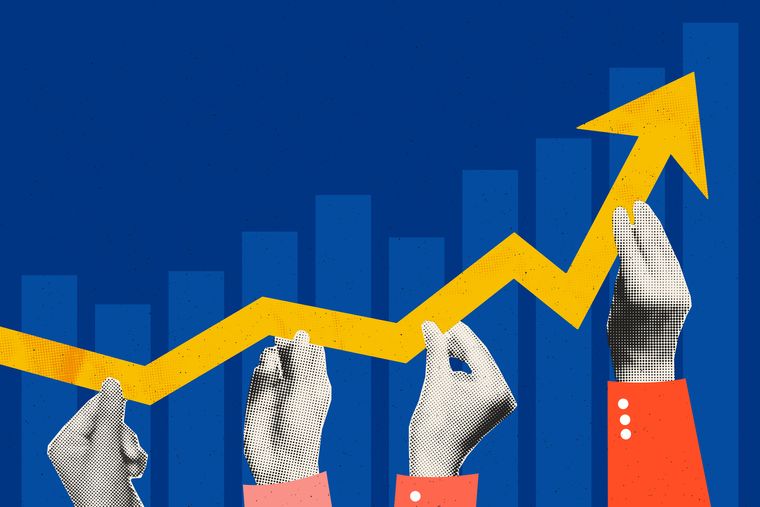Top 10 global consumer trends 2022
This year, consumers are taking back control

Upheaval and uncertainty defined the past two years. The COVID-19 pandemic abruptly changed routines, plans and perspectives. Embracing the unknown was the new normal.
This year, consumers are taking back control. 2022 will be fueled by intentions. Consumers want to live in the moment, seize opportunities and take chances. They are determined to live their best lives and reach their full potential.
Euromonitor International depicts the 10 consumer trends that will manifest in the year ahead.
 Top 10 global consumer trends 2022
Top 10 global consumer trends 2022
Backup planners
Backup Planners are getting ahead of the crowd, taking control and using technology to move to the front of the queue when supplies are threatened. Certain consumers are relying on subscription services or community group buying to secure deliveries. When thwarted, Backup Planners are reverting to the next best option, seeking alternatives and in some cases, delaying purchases or changing shopping habits. Two extremes are influencing shopping behaviours of Backup Planners—paying a premium or switching to cost-effective options, such as buying secondhand or renting.
Supply chain shortages continue to disrupt the marketplace and create ongoing challenges. Companies are struggling to secure necessary resources to manufacture products, leading to out-of-stock inventory or massive delivery delays.
To overcome this issue, Backup Planners are finding alternative products and services or looking for workarounds to be able to purchase their go-to items. Businesses are forced to pivot and provide new solutions, implementing direct-to-consumer or rental models, for example, to keep their offerings accessible.
Climate changers
The climate emergency is escalating. Green activism becomes the norm for climate changers and is reflected in purchase decisions that emulate their low-carbon lifestyles. These consumers expect brands to step up and drive change too.
 Source: Euromonitor International Voice of the Consumer: Lifestyles Survey 2021
Source: Euromonitor International Voice of the Consumer: Lifestyles Survey 2021
Companies need to reduce their own carbon footprint and provide tools that help consumers track their environmental impact. Transparent labeling of carbon-neutral products is a step in the right direction to build trust and enable consumers to make informed choices.
Digital seniors
Store closures, self-isolation measures and in-person restrictions during the pandemic forced senior citizens to use the online channel—some for the first time. Now, these older consumers have become familiar and comfortable with technology. Digital seniors are more confident navigating the digital space and are shifting their behaviours as a result.
For businesses, opportunities abound to tailor virtual experiences that meet the needs of this new online audience. Easy-to-use technology and seamless solutions combined with face-to-face communication define the future of digital inclusion for seniors.
Financial aficionados
Smart money management is becoming more attainable. The economic shock from the pandemic prompted consumers to strengthen their financial security. These savvy savers are improving their financial literacy and gaining confidence in investing.
 Source: Euromonitor International Voice of the Consumer: Lifestyles Survey 2021
Source: Euromonitor International Voice of the Consumer: Lifestyles Survey 2021
Financial aficionados take control of their money and use services to track their transactions. Consumer-friendly platforms and free educational resources can build financial acumen and empowerment.
The great life refresh
The past 18 months were filled with reflection. This year, consumers have a new lease on life and are embarking on the great life refresh. Career changes, new business ventures and pet adoptions, among other activities, are at the forefront of this trend.
Businesses need to innovate goods, services and experiences that respond to this once-in-a-generation moment. Companies catering to the great life refresh stand to be seen as partners, helping consumers adapt to a new way of life.
The metaverse movement
Immersive digital ecosystems begin to transform virtual connections. Though nascent, consumers and companies are starting to explore the metaverse. These 3D virtual worlds are capable of evolving social interactions, customer relationships and brand engagements.
The metaverse movement provides an opportunity for experimentation and innovation. As access and the user base expands, brands have the potential to increase awareness and reach new audiences.
Pursuit of preloved
Secondhand shopping and peer-to-peer marketplaces are booming. Whether to save money, reduce waste or find a unique piece, consumers are on the pursuit of preloved.
 Source: Euromonitor International Voice of the Consumer: Lifestyles Survey 2021
Source: Euromonitor International Voice of the Consumer: Lifestyles Survey 2021
Businesses also need to invest in the circular economy, such as recycling, rental or resale programmes. These initiatives give consumers more value for money while also positively impacting the environment.
Rural urbanites
Relocation is on the rise. The desire for less congestion and pollution attracted consumers out of cities into suburban and rural neighbourhoods. But not all city dwellers want to uproot; however, these consumers also want more space and sustainable communities.
Rural urbanites seek the best of both worlds: the convenience and proximity to goods and services that cities offer combined with the space and greener scenery of rural areas.
Businesses and governments are striving to create mini cities where shops, restaurants and schools, among other establishments, are within a 15-minute commute. Expanding brick-and-mortar outlets whilst investing in e-commerce will help companies reach a broader audience.
Self-love seekers
Happiness, acceptance and owning their originality are at the core of self-love seekers. These consumers embrace their individuality with confidence and pride. They indulge and invest in goods and services that elevate their sense of self.
Businesses need to support and enhance consumers’ lives. Products and services that help consumers feel fulfilled, positive and self-assured will improve brand perception.
The socialisation paradox
Returning to pre-pandemic life is fragmented based on varying comfort levels. Certain consumers are eager to socialise and resume in-person engagements outside the home whilst others are reluctant to revert to such activities, creating The socialisation paradox.
 Source: Euromonitor International Voice of the Consumer: Lifestyles Survey 2021
Source: Euromonitor International Voice of the Consumer: Lifestyles Survey 2021
For businesses, this divide creates complications. Remote work and virtual events will co-exist with in-person engagements, but consumers want the option to choose. Hybrid solutions need to be provided without sacrificing the customer experience.
How do companies stay top of mind in 2022?
Product efficacy is only one of several factors that influence a purchase decision today. Consumers will gravitate towards companies whose values, business practices, corporate social responsibility and sustainability goals align with their morals. And the customer experience needs to be unparalleled.
Consumers want to be heard, valued and supported along their journeys. Developing deep, supportive connections will push companies beyond the purchase to become trusted allies.
Find inspiration and business solutions for each of these trends in our full report, “Top 10 Global Consumer Trends 2022,” and join our webinar on 24 February to get strategic insights directly from our experts.
Source: Euromonitor International Voice of the Consumer: Lifestyles Survey, fielded January and February 2021. Results are drawn from online consumers ranging in age from 15 to 65+. 2021 n = 40,732. Between 1,000 to 2,000 consumers in each market are surveyed each round. Markets surveyed include Argentina, Australia, Belgium, Brazil, Canada, Chile, China, Colombia, Denmark, Egypt, France, Germany, Hong Kong, India, Indonesia, Italy, Japan, Malaysia, Mexico, Morocco, Netherlands, New Zealand, Nigeria, Peru, Philippines, Poland, Russia Saudi Arabia, Singapore, South Africa, South Korea, Spain, Sweden, Taiwan, Thailand, Turkey, United Arab Emirates, United Kingdom, USA and Vietnam.
Alison Angus
Head of Lifestyles at Euromonitor InternationalAlison heads up the lifestyles and megatrends research focused on understanding consumer behaviour, attitudes and shifting trends, interpreting these into informative and useful insights to support businesses and strategy planning. Alison has worked in research for 20 years, covering consumer goods, home entertainment and service sectors. She brings extensive knowledge and expertise on research and analysis techniques and methodologies, managing projects and producing informative and insightful analysis.


